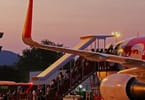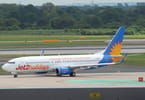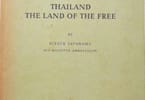Over the years, there have been intense debates about whether the short-haul, low-cost concept can be extended into long-haul operations.
For AirAsia X, an airline that embraced the low-cost, long-haul concept in 2007, it continues to get accolades for its performance. In fact, last year in November, it was reported that AirAsia X was profitable. Also, the Centre for Asia Pacific Aviation (CAPA) had indicated that the outlook for AirAsia X remains strong – the “fourth quarter (is) looking positive with strong loads and high yields.”
At the time of launch, it was shared that AirAsia X’s network focus will cover destinations which are more than four hours in flight duration from Kuala Lumpur, offering daily point-to-point frequencies. As of today, its growing network includes services to Australia, China, Taipei, the United Arab Emirates, and the United Kingdom.
“People want to travel for a wide variety of reasons, and our affordable fares allow them to travel with good value-for-money,” airline’s CEO Azran Osman-Rani http://events.eyefortravel.com/tdasia/index.php/2010-speaker-list told EyeforTravel’s Ritesh Gupta.
Osman-Rani, who is scheduled to speak at the Travel Distribution Summit Asia 2010 (to be held in Singapore, April 28-29 http://events.eyefortravel.com/tdasia/index.php/distribution-a-sales ), spoke about the next big thing for travel in Asia and airline’s plans. Excerpts:
What, according to you, is the next big thing for travel in Asia?
Azran Osman-Rani: Multi-destination holidays. Instead of just visiting one place and flying back, we’re now seeing a clear trend of travelers taking advantage of the exploding new air connectivity across Asia and low fares to plan two or more destinations as part of the holiday – enriching the overall holiday experience by combining the best of different regions.
For example, a European visitor flying from London into Kuala Lumpur can experience great shopping and eating in KL, venture off to Siem Reap to see the amazing Angkor Wat in Cambodia, and then make their way to Bangkok and Phuket for the tropical island experience. Alternatively, an Asian tourist flying into Australia can hop from the cosmopolitan city of Melbourne and its vineyards, to the family theme parks [on the] Gold Coast, and then on to Cairns and the once-in-a-lifetime Great Barrier Reef experience.
In October last year, AirAsia X stated that while 2Q 2009 was the most difficult period yet for the low-cost, long-haul carrier, with high pressure on yields and load factors, encouragingly, volumes have picked up again in the third quarter of 2009.
Can you reflect upon the demand for such service at this juncture?
Azran Osman-Rani: There’s a longer lead time for long-haul travel. 2Q 2009 was the toughest, because we were still in the depths of the economic recession, and we had the H1N1 scare. However, things started to pick up in Q3 and kept strengthening in Q4. We managed to end the year with the same number of passengers and load factor that we set out for ourselves, with Q4 making up for the Q2 shortfall. International travel is indispensable. People want to travel for a wide variety of reasons, and our affordable fares allow them to travel with good value-for-money.
Can you elaborate on expansion plans, route-wise and aircraft-wise, for AirAsia X? What factors are driving these expansion plans?
Azran Osman-Rani: Ultimately, you have to have scale in the airline business. We’re already the world’s lowest unit cost operator, but we want to keep driving this down further.
With our planned four new aircraft entering into service in 2010, we expect to get a further 18 percent reduction in non-fuel operating cost. We also want to expand our footprint further in our Asia Pacific network, with a focus on routes that will provide feed[s] into other routes. India will be a big part of AirAsia and AirAsia X’s expansion plans for 2010 – we want to replicate our unrivaled network in China there, where we serve not just the main cities but secondary cities not served by other airlines.
Late last year, AirAsia Group indicated that the group is well placed to take advantage of the prevalent situation, especially considering that airports are offering attractive deals in return for growth and also other airlines are not introducing new routes, thus making it easier for AirAsia to expand. How do you assess the situation from AirAsia X’s perspective?
Azran Osman-Rani: Same with us. More important than just a good financial deal, is finding airports that act as partners in jointly developing the new markets that we create through a lot of co-marketing, joint problem solving, and industry engagement. We value active partners who work side by side with us.
AirAsia Group indicated that it is on course to achieve the group’s target of carrying 25 million guests for the full year 2009. How do you assess AirAsia X’s performance last year?
Azran Osman-Rani: We survived 2009 in a much sounder position than most legacy carriers. We met our passenger targets, and we even operated profitably for a relatively small airline.
Recently, AirAsia and Jetstar came up with a non-equity partnership. Can you elaborate on what impact it is going to have on long-haul travel? How can we expect AirAsia X to benefit from this?
Azran Osman-Rani: Too early to provide details. The primary focus on this alliance is on narrow-body aircraft purchases and parts/services pooling. Opportunities in long-haul would follow later.
What are your targets for this year? What’s on your agenda?
Azran Osman-Rani: Growth! More planes, more destinations, more profits. We’re also looking forward to delighting our guests with yet another innovation – premium lie-flat bed seats – the first of its kind for a low-cost carrier and not just any LCC, but the world’s lowest unit cost carrier.
* * * * * * * * * * *
Azran Osman-Rani is scheduled to speak along with John Koldowski – director, Strategic Intelligence Centre, PATA; Rob Bailey – president & CEO, Abacus International; and William Bao Bean – senior analyst, Softbank Venture Capital in the inaugural session of Travel Distribution Summit Asia 2010 (to be held in Singapore, April 28-29
For more information on Travel Distribution Summit Asia 2010, go to: http://events.eyefortravel.com/tdasia/index.php/distribution-a-sales
WHAT TO TAKE AWAY FROM THIS ARTICLE:
- Instead of just visiting one place and flying back, we're now seeing a clear trend of travelers taking advantage of the exploding new air connectivity across Asia and low fares to plan two or more destinations as part of the holiday – enriching the overall holiday experience by combining the best of different regions.
- For example, a European visitor flying from London into Kuala Lumpur can experience great shopping and eating in KL, venture off to Siem Reap to see the amazing Angkor Wat in Cambodia, and then make their way to Bangkok and Phuket for the tropical island experience.
- In October last year, AirAsia X stated that while 2Q 2009 was the most difficult period yet for the low-cost, long-haul carrier, with high pressure on yields and load factors, encouragingly, volumes have picked up again in the third quarter of 2009.
















![China's Hyperloop Train: A Glimpse into the Future of Transportation 14 Travel Tourism News | Domestic & International Hyperloop Train China [Photo: Hyperloop Transportation Technologies]](/cdn-cgi/image/width=145,height=100,fit=crop,quality=80,format=auto,onerror=redirect,metadata=none/wp-content/uploads/2024/02/180720163348-hyperlooptt-china-capsule.jpg)





